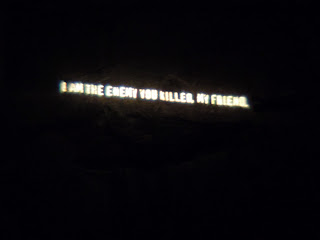 |
| After taking an elevator down we encountered the chalk tunnels |
 |
| One of the many air shafts for ventilation |
 |
| Cross carving done by a soldier |
 |
| While we had great lighting in the tunnels during WWI the tunnels were not well lite. The little light on this pole shows what the kind of lighting the WWI soldiers had...it wasn't much. |
 |
| The altar where many soldiers went for Easter Service in 1917, prior to going out to fight the following morning. |
 |
| One of the many rooms found throughout the tunnels |
 |
| Another drawing on a wall done by a soldier |
 |
| This is exit 10 (I used a flash on my camera) Just one of the many exits used on Easter Monday where the soldiers rushed out to meet the Germans just in front of their defensive line |
 |
| Some of the soldiers who worked and lived down in the tunnels |
 |
| Through the tour we learned how the soldiers lived in these harsh conditions. |
 |
| sample of their sleeping quarters |
 |
| Tunnel equipment |
 | |||||
| The sign above our exit from the tour which says "I am the enemy you killed, my friend." |



Oi vey! Once again, I get claustrophobia just thinking about having to go in those tunnels, much less live in them! Six months! I can hardly imagine how it must have felt for them when they left the tunnels, half euphoria and half dread, mixed with some nervous system over stimulation. I wonder what percent of the soldiers that lived there that long, survived....
ReplyDeleteWow, I could relate to this one. My grandfather was killed in France during this war. He was in one of the trenches. He was buried there and then a couple of years later his body was brought back to his family. What a story today and the pictures told the story too. Thanks, for this adventure!
ReplyDeleteWow, this is simply amazing. I can imagine living in a tunnel, but that is as far as it goes...my imagination. What brave men!
ReplyDeleteThank you so much again for stopping by my blog! :)
Wow!!! That is amazing. Living in a tunnel!!! What an experience to see that!
ReplyDelete